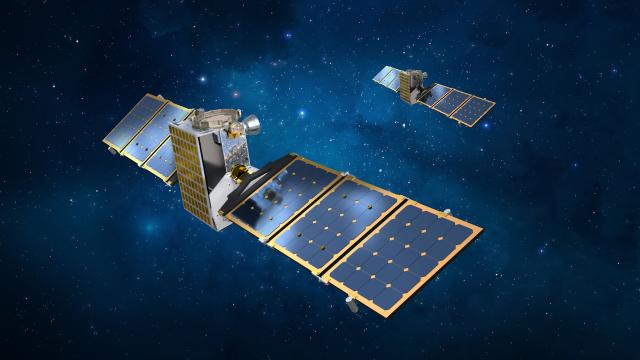A software glitch has caused the delay of Psyche, a NASA mission to explore a metal-rich asteroid. Two small probes are being included in the launch, but the postponement means they might not be able to rendezvous with their respective target asteroids.
Psyche, a probe designed to explore the unusual metal-rich asteroid 16 Psyche, is currently undergoing preparations at Kennedy Space Centre in Florida. Mission engineers recently spotted an anomaly that resulted in the launch delay.
“An issue is preventing confirmation that the software controlling the spacecraft is functioning as planned,” NASA announced in a May 24 press release. “The team is working to identify and correct the issue. To allow more time for this work, the launch period is being updated to no earlier than Sept. 20, 2022, pending range availability.”
The Psyche launch was supposed to happen in early August, but this small delay is causing a huge problem for planners with the Janus mission — a project to explore two unrelated binary asteroids. The twin probes are joining Psyche for the same SpaceX Falcon Heavy launch, but the delay means the mission won’t unfold as planned, as Dan Scheeres, the principal investigator of the project and an astronomer at the University of Colorado, explained at a session of NASA’s Small Bodies Assessment Group (SBAG) on Wednesday.
The Janus project is one of three planned missions under NASA’s Small Innovative Missions for Planetary Exploration (SIMPLEx-2) program, the other two being Escape and Plasma Acceleration and Dynamics Explorers (EscaPADE) and Lunar Trailblazer. For the $US55 ($76) million mission, the suitcase-sized twin Janus spacecraft were designed to rendezvous with two pairs of binary asteroids, designated 1996 FG3 and 1991 VH.
Scheeres and his colleagues are hoping to study the complex orbital dynamics of the binary asteroids and create accurate models of the two systems, which they would do using a suite of cameras mounted onto the probes. By studying the asteroids from up-close, scientists will gain an improved understanding of the early solar system and acquire important insights that could improve planetary defence strategies against threatening near-Earth objects.
“The Janus mission, as conceived of and proposed to NASA, will give us information on how rubble pile asteroids evolve over time,” Scheeres explained to me in an email. “There are fundamental questions about how small, weakly bound rubble piles change over time, which has implications for a range of phenomena in the solar system — ranging from the protoplanetary disk to planetary rings to the after-effects of catastrophic disruptions.”
The Janus mission, or at least the original iteration of the mission, was to provide new data about these processes and properties. Scheeres said a modified mission could still address these questions, but at reduced resolutions.
Under the original mission parameters, the Janus probes were scheduled to perform a series of Earth flybys to meet up with the asteroids in four years, but Scheeres said the delayed launch means these critical flybys are no longer possible. “Our spacecraft were designed to be launched during August — it allowed us to be properly timed to get to our target asteroids,” Scheeres wrote. “The slip into September mostly makes this timing not feasible, except for a few days.” That said, there “are launch days when we will be able to flyby our original targets,” he told Gizmodo, but “most of the days we cannot reach them,” adding that the best-case scenario “would be to launch on those days we can get there.”
Scheeres and his colleagues are in the midst of locating other asteroids that are “scientifically interesting which we could reach on other days of the launch period,” he said. “We would just need to refocus our science goals.” One potential target, 1996 FG3, could be reached by both Janus probes should Psyche launch between October 7 and 10, according to SpaceNews. But as a rideshare mission, the team has “no ability to influence the launch dates or the targeting of the launch vehicle, and that arises from our status as a rideshare,” Scheeres pointed out at the SBAG meeting.
Such is the fate of ridesharers, who must stand by and watch situations unfold outside of their control. “It is frustrating, of course,” he told me. “However, these are the rules for rideshares, so it’s not like we didn’t know that this might happen.” Indeed, hitching a ride atop rockets makes low-cost missions to space possible, but it’s not without risks. Speaking to the SBAG meeting attendees, Scheeres said rideshare partners should have their voices heard, adding that some considerations should be made “for small adjustments to launch dates.”
As for pulling out of the Psyche mission and finding a new launch provider, Scheeres says that’s not being considered. He said no known future launch can accommodate and meet the needs of the Janus rideshare mission. That’s unless someone is willing to fund an independent launch, which doesn’t appear to be in the cards. Space is hard, as the saying goes, but in this case it’s getting to space on time that’s proving to be the issue.
More: NASA’s Latest Plan to Fix Trojan Spacecraft’s Unlatched Solar Array Shows Signs of Promise.
